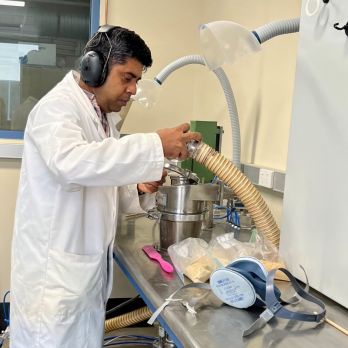Food pilot laboratory
The plant-based food sector is rapidly emerging in Australia, with consumers embracing plant-based foods as a part of their diet.
Enhancing the technology and research capability for plant-based foods will attract further investment in South Australia.
Our research increases the potential value-adding, food manufacturing and export opportunities for plant based-food.
Equipment and technology
The food pilot laboratory's infrastructure enables experimental and pilot trials, in liaison with industry.
Most equipment is suitable for working with a range of raw materials and ingredients, both animal and plant-based.
Ingredient and food processing equipment
Jet mill and air classifier:
- pilot scale dry fractionation of cereals into protein and starch rich fractions
- processes up to 10kg of grain per day.
Thermo scientific extrusion systems:
- suitable for both low and high moisture extrusions, producing snacks, plant-based dry protein ingredients, and fibrated protein products
- lab scale (11mm) processes volumes of 0.02 to 2.5kg
- pilot scale (24mm) processes volumes of 0.5 to 50kg.
Armfield ultrahigh temperature processing system:
- processes liquid and semi-liquid foods, and beverages to commercial sterility, including baby foods, condiments, milk, ice-cream, yogurt, desserts and puddings, purees, sauces and soups
- typical processing flow rates are 10 to 20 litres per hour with holding temperatures up to 150°C
- at pasteurisation, temperature flow rates of up to 60 litres per hour are achievable, with minimum processing volumes for some products.
TERRA food-tech retort:
- benchtop autoclave designed to cook, pasteurise or sterilise packaged foods, for developing new formulas and containers
- processing parameters (temperature and pressure) can be controlled, suitable for glass jars with metallic lids, pouches and plastic containers, and cans.
- capacity is 50 litres.
Vincent screw press:
- horizontal screw press to dewater or concentrate product streams, such as food wastes, fruit and vegetable juicing, citrus peels
- liquid is forced through a static screen by a rotating screw
- press cake moisture is controlled by a discharge cone actuated by an air cylinder
- capacity is 70 to 225kg per hour for feed rate.
Vacuum packaging machine and bag sealer.
Two-stage homogeniser.
Blast chiller and freezer.
Temperature and humidity cabinets.
Analytical equipment
Particle size analyser – measures the particle size of milled and fractionated flours.
Protein analyser – accurately measures protein levels in raw materials and foods.
Fibre analyser – insoluble, soluble and total fibre measurements in raw material and food samples.
Texture analyser – tests food:
- firmness
- consistency, flow and body
- spreadability
- tear or burst strength
- breakage and shearing
- textural properties of bakery products, cereals, confectionery, snacks, dairy products, fruit and vegetables.
Near infrared food analyser – routine analysis of quality parameters during food production, such as:
- moisture
- protein
- fat
- gluten.
Viscometer:
- analyses the viscous properties of food ingredients, such as starch, grain, and flour, as they are heated and mixed in the presence of water
- temperature ramping allows test temperatures up to 140°C.
Drying equipment
Benchtop freeze-dryer – used especially for heat-sensitive materials.
Lab scale spray dryer – processes varied liquid foods and liquid food ingredients.
Lab scale fluid bed dryer:
- forces air through a bed of particles so the particle bed assumes a fluid-like state
- provides thorough mixing and maximum contact of solid with moving air, by heating the incoming air and managing air flow rate through the sample
- ensures faster and more homogeneous drying than other methods through high rates of heat and mass transfer – drying times range from a few seconds to minutes
- dries materials with moisture contents of up to 80%.
Lab scale microwave drying oven:
- dries a batch of samples in under 15 minutes
- uniform temperature distribution.
Vacuum drying oven:
- used for substances with unstable temperatures and oxidation sensitivity
- dries parts with complicated shapes and unreachable holes.
Small commercial tray dehydrator:
- 2.5 m2 drying area on solid and mesh trays
- 30 to 90°C operating temperature.
Contact
Dr Maria Saarela – Food pilot laboratory
Phone: (08) 8429 3534
Email: maria.saarela@sa.gov.au






